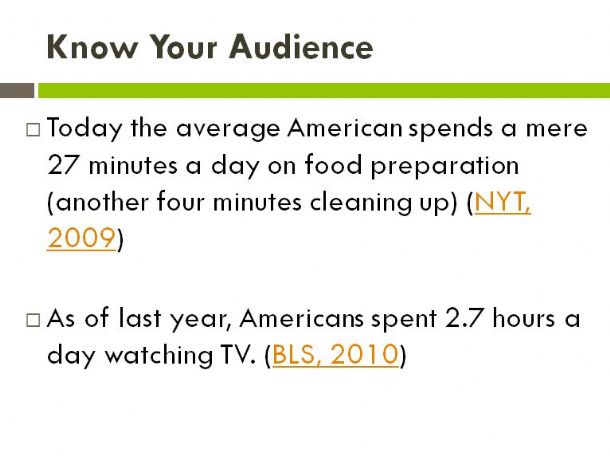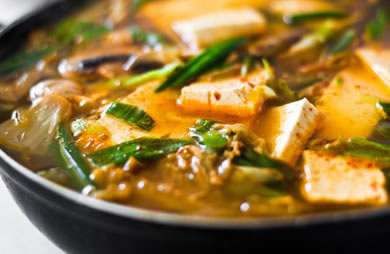I recently spoke at the Healthy Living Summit on the topic of writing a better recipe. Participants asked me to share my presentation, so I am posting it here, with notes that make it helpful for those of us who also share our recipes on SparkRecipes.com.
Before I delve into the recipe writing tips, let's talk about recipes for a bit.
As the editor of dailySpark.com and SparkRecipes.com, I'm always on the lookout for talented healthy home cooks. With more than 300,000 recipes on the site, it can be difficult to choose among them. I hope that you'll share this blog post with your friends (both on SparkPeople and on other sites) and encourage them to publish their recipes on SparkRecipes. Good recipes are featured on the homepage, in our daily email newsletters and elsewhere on the site.
“I invite you to skip the technology, the SEO, and all the other shoulds you’ve collected up along the way. Instead, step up to that darling morsel and sink your teeth in.”
--Brooke Burton, FoodWoolf.comSometimes we forget that recipes are stories, meant to entice the reader into making a dish. We, as food bloggers, worry more about aggregating audience and increasing SEO than we do about the words on a page.
I sat in on a session that Brooke Burton moderated at last year's Food Buzz Festival in San Francisco. She was enthusiastic and encouraging as she and her fellow panelists urged us to invoke all our senses as we wrote. This quote, borrowed with citation from her blog, seemed a fitting reminder for the topic of better recipe writing.
Let's get started!

- That is, they don’t have time to waste in the kitchen.
- When readers come to your site looking for recipes, they don’t have the time, energy, or resources to experiment. They come looking for the perfect grilled cheese, a fool-proof quiche, and the best chocolate-chip cookies. That's what we should deliver.
- Know your audience. Most people don't cook, so you'll need to explain actions like dredge, julienne, deglaze, etc.
- If you're an expert or a seasoned home cook, consider adding a glossary to your site. If not, link to another glossary (I love epicurious.com's food and wine dictionaries.) Or, if you are a niche blogger who uses rare ingredients often, consider creating a page that explains what these foods are.
- The dishes you share don’t have to be simple, but your recipes should be.
What’s your pet peeve with recipes?
Think for one minute, then write down your top three.
Examples:
- Too many photos… too much scrolling!
- Missing ingredients
- Unclear directions.
- Obscure ingredients…
Mine are:
- Time-consuming prep that the writer didn’t mention until halfway through the recipe! Now, cook your beans for an hour…
- Recipes that cook at odd temperatures or for odd times: 315 degrees for 7 minutes.
- Random capitalization: boneless, skinless Chicken Breasts
.png)
Choose your words!
- Be descriptive! Use your words!
- Don’t just tell me. Show me. Use all five senses to describe a food:
- Touch/sound: crispy fillo dough, crunchy graham cracker crumbs, berries that burst when bite into them
- Sight: delicate custard flecked with bits of bright green lime zest
- Taste: the sour lime hits your palate first, followed by the slightly tart unsweetened whipped cream
- Smell: fresh citrus smell permeates your kitchen



A good headnote is one to two sentences to draw the reader in. Here you’ll share a brief anecdote, the history of the recipe.
Remember not everyone reads the entire blog post--they look at the pictures and skip to the recipe. Consider adding a headnote to your recipe, even if you've already shared a story up top. This is the place to talk about obscure ingredients, new techniques, etc.
Ex: This recipe uses broccoli stalks. Offer a tip on how to peel off the tough outer layer and shred it into slaw.

Mama Pea’s draws in the reader with a bold claim. You want to see if it lives up to its expectations—and it does. She sells it.
Angela’s headnote is lengthy, but she’s offering:
1. a description
2. alternative cooking techniques
3. a gluten-free swap
4. helpful tips

- One of the most common recipe omissions out there!
- If you’re single, you might not want to make something that serves 8.
- If you have a family of four, you need to know ahead of time if you need to double the recipe.
- TIP: keep cookies, muffins, etc. to a round dozen. If your recipe hasn't made a dozen, check to make sure that your treats are all a uniform size.

Things to consider:
- A slow cooker recipe with 6 hours cook time, but only 10 minutes of prep is a lot different from a salad with 30 minutes of prep time but no cooking.
- If you’re an expert at chopping, add 10 minutes or so to your prep time
- Ex: 1 (14.1 ounce can) most sizes are standard, and the more recipes you write, the easier it will be to remember these.

- Calculate the yield: 1 large onion equals how many cups chopped?
- If possible, use a whole can of something to make life easier—or offer tips on what to do with the leftovers.
- Get familiar with yields. Ex. 1 pound dried beans= about 6 cups cooked for example
- Details matter. Ex: 1 cup chopped almonds or 1 cup almonds, chopped. The yields are quite different!
- Avoid double listing. Write the entire amount in the ingredients list, then be specific in the instructions. (Add 1 cup of flour. … Add the remaining half cup of flour.)
- Create subheadings for ingredients. For the sauce, for the filling. Etc
- Don't use brand names or specific varieties unless necessary--especially if your audience is nationwide or international.

What I changed:
- Ingredients in order
- Added sizes for cans
- Added specifics on mango
- Added enchilada sauce*
- Specified tortillas
- Spelled out measurements
- Specified ground or whole cumin

- Do not use telegram-like instructions, but be concise. Use articles! Puree the soup, add the onions, chop a carrot
- Be descriptive. Use all your senses. What are you looking for, smelling, seeing, as you're cooking. The almonds are toasted when you can start to smell them.
- Start with a verb: Chop the parsley, stir the soup, dice the peppers DO NOT START With a prepositional phrase: into a large bowl, pour the ingredients.
- Don't specify pan size, but know the difference between pot (for liquids), pan, dish.
- Use specific terms--and know them: batter, dough, custard, dry ingredients, wet ingredients.
- Simplify directions by adding detail to the ingredients list: 1 tomato, seeded and chopped; 1 pound chicken breasts, trimmed and butterflied.
- Be accurate in description. Don't just say "brown"--say light golden brown

What I changed:
- Rearranged steps.
- No need to say “on the stovetop”
- Chose more specific verbs.
- Added articles.
- Gave details on when to proceed to next step, when things are ready.
- Ex: Cooking…
- until the mango is heated through
- until the cheese is melted
- until the sauce is bubbly


Great example of linkbacks:

Special thanks to...
- Angela of OhSheGlows.com
- Emily of DailyGarnish.com
- Ashley of EdiblePerspective.com
- The Healthy Living Summit planning committee--especially Heather for her stellar introduction and Meghann for all her hard work!
- All “good” examples used with permission from bloggers.
- All “bad” examples were altered to protect the privacy of authors.
Now I hope that you'll all share your recipes on SparkRecipes.com! (Know someone who might like this blog post? Be sure to share it!)
What questions do you have regarding recipe writing? What is your biggest challenge?
Want more healthy recipes from Chef Meg, me and fellow SparkPeople members? Be sure to subscribe to SparkPeople's Recipe of the Day email. Click here to sign up! Did you know SparkRecipes is now on Facebook? Click here to "Like" us!
Photo credits: Randall Hoover Photography, unless noted
|
|


.png)


























.jpg)
